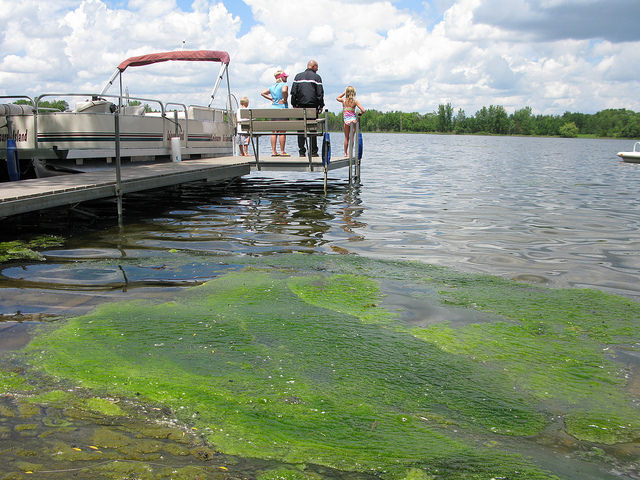Warmer Weather, Warmer Water
The early spring in most parts of the state prompted earlier ice out dates than normal. With the ice off of the lakes the water has had more of a chance to warm up than it usually does by Memorial Weekend. While most people don’t spend much time swimming over this holiday weekend here’s something to keep in mind for a little later in the summer.
Blue-green algae: If in doubt, stay out
For release: May 26, 2016
Contact: Risikat Adesaogun, MPCA, 651-757-2056 or Doug Schultz, MDH, 651-201-4993
photos of algae blooms from MPCA
St. Paul, Minn.—With Memorial Day right around the corner, the unofficial start of summer is here. While water enthusiasts and pets enjoy swimming and boating when the weather is calm and sunny, these conditions are also perfect for growing blue-green algae, which can be harmful to both people and animals.
Last summer, blue-green algal blooms were reported in lakes across the state, from near the Iowa border all the way to the Canadian border. The Minnesota Pollution Control Agency (MPCA) and Minnesota Department of Health (MDH) staff jointly investigated two reported human illnesses and multiple dog deaths following exposure to blue-green algae. Blooms typically begin to form in June when the weather warms, but with the mild spring weather this year, blooms may already be present in Minnesota lakes.
People and pets at risk
The appearance of a blue-green algal bloom and the unpleasant smell that occasionally accompanies a bloom typically keep most people out of the water. However, people can become sick after they swim, boat, water ski or bathe in water that has toxic blue-green algae. During these activities, people are exposed to the toxins by swallowing or having skin contact with water or by breathing in tiny droplets of water in the air. “In most people, symptoms are mild and may include vomiting, diarrhea, rash, eye irritation, cough, sore throat and headache,” said MDH Epidemiologist Stephanie Gretsch.
Dogs are at particular risk, as they are more likely to wade in the areas of a lake where algal scum accumulates and humans avoid. Dogs are usually exposed to larger amounts of toxins from algae because they tend to swallow more water than humans while swimming, especially when retrieving toys from the water. They also lick their coats upon leaving the water, swallowing any algae that may be on their fur. Dogs exposed to blue-green algae can experience symptoms such as vomiting, diarrhea, rash, difficulty breathing, general weakness, liver failure and seizures. In the worst cases, it can cause death. If your dog experiences any of these symptoms after visiting a lake, seek veterinary care immediately.
Tips to protect yourself and your pets
Not all blue-green algae are toxic, but there is no way to tell whether a bloom is toxic by looking at it. Harmful blooms often look like pea soup, green paint or floating mats of scum and sometimes have a bad smell. However, harmful blooms aren’t always large and dense and can sometimes cover small portions of the lake with little visible algae present. Before you or your children or pets enter the water, take a closer look at the lake and check for algae in the water or on shore to help determine if a bloom recently happened.
“If it looks and smells bad, don’t take a chance. We usually tell people: If in doubt, stay out,” said Pam Anderson, MPCA Water Quality Monitoring Supervisor. “If you’re not sure, it’s best for people and pets to stay out of the water.” If you do come into contact with blue-green algae, wash off with fresh water immediately, paying special attention to the areas your swim suit covered. Rinse off pets with fresh water if you think they swam in water where blue-green algae were present.
Addressing the algae problem
There are currently no short-term solutions to fix a blue-green algal bloom. Once a bloom occurs, the only option is to wait for the weather to change to disrupt the algae’s growth. “With intermittent rain, followed by high temperatures, blue-green algal blooms will be common on many Minnesota lakes this summer,” said Steve Heiskary, an MPCA Research Scientist.
The key to solving algae problems is to improve overall water quality by reducing how much phosphorus gets into lakes. Phosphorus is a nutrient that encourages plant growth, and it is present in soil and plants. Runoff from urban and agricultural land contains phosphorus. Excess phosphorus in lakes provides the food necessary to produce algal blooms. Aside from limiting applications of fertilizers that contain phosphorus, homeowners can help protect our lakes by sweeping up lawn clippings and soil off sidewalks and pavement, and cleaning up pet waste, so that rain storms don’t wash the material into nearby lakes and rivers.
More information on blue-green algae, including how to report a possible human or animal illness, is available on the MDH Harmful Algal Blooms website.


Leave a Reply
You must be logged in to post a comment.